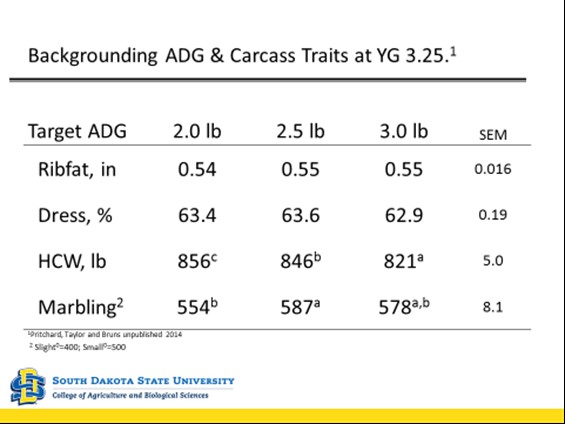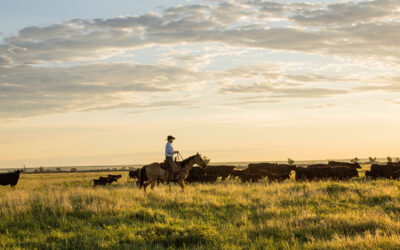
Precision for modern cattle
by Miranda Reiman
Backgrounding today’s cattle on yesterday’s “prescription” can mean missed profit opportunities.
“We can map to hit whatever target anybody wants us to hit,” says Robbi Pritchard, South Dakota State University animal scientist. “All we need to do is manage our stage of growth, oversee the implant, get the correct intake—and we start at ranch time.”
Ranches have differentiated their calves over the years, so it’s time to look at what each set of cattle needs before putting them in a routine program.
Kelly Bruns, University of Nebraska west central research and Extension director, worked with Pritchard and his team to study the ideal.
“Rather than have a prescription backgrounding diet for every set of calves that come in, can I strategically, or as Pritchard calls it, ‘precision’ background them to maximize my outputs?” Bruns asks.
That’s the question brought on by an evolution in genetics and management.
- Breeding seasons are tighter. “We no longer need time to get the skeleton to grow. We no longer need time for things to average out,” Pritchard says. “Time solved a lot of problems with cows, but with quality-managed cattle today, we don’t have to fiddle around with that time.”
- Growth genetics are the norm. When Pritchard started out decades ago, “very profitable” calves converted at 8.5:1 pounds (lb.) of feed to gain. “Growth potential is greater. The rules have changed,” he says. “If [calves] are coming out of 1,600-lb. cows, they probably don’t need any implants. The DNA is there. The implants just fill in for a lack of DNA.”
- Marbling genetics have improved. “In the old days, bigger meant older. I had to let that frame grow. In the old days to get quality grade, they had to be older,” Pritchard says. “It used to be an adage that calf-feds couldn’t grade. That doesn’t exist anymore.”

The first step is deciding to modify the growing program. That begs a question: “how?”
Evaluate end goals and define quality grade and size targets, the animal scientists say.
“The game gets played everywhere from weaning day to about 65% of their harvest weight,” Pritchard says. “That’s where you change the percent Choice, that’s where you change what they’ll weigh when they hit yield grade 4 (YG4). That’s the window.”
Smaller to moderate-frame cattle need a more aggressive implanting program than the larger frames. It’s also important to consider final marketing method and quality grade potential, Bruns says.
“If we choose to use an implant, are we matching the correct level of the implant, such as low, medium or high potency to what their rate of gain is?” he asks. “Going back to all our previous marbling work, if we use too high potency of an implant and don’t match it up with a high enough caloric diet, we could impede marbling.”
When implanted, large-frame cattle run the risk of being heavyweight discounts in the packing plant.
“Once you put implants in that kind of DNA, now all a sudden you have a $10,000 nitro-burning car that flames out. It’s not a good thing,” Pritchard says.
That’s not all set on day one.
“Even genetics in the same pool can change carcass weight by how we background them,” Bruns says.
Researchers looked at targeted daily gains for backgrounding from 2 to 2.5 and 3 lb. The cattle finished on the same diet, for a similar number of days, to a consistent .5 inch of backfat.
“The slower they grow during backgrounding, the more they eat during finishing,” Pritchard says, noting the 2 lb./day group finished with a 4.09 lb. average daily gain (ADG), compared to the fastest growing backgrounders at 3.58 lb. The middle group (2.5 lb.) only gave up a little in finishing to hit 3.9 lb. ADG.
“All of this manipulation was happening during the backgrounding phase. That’s the trick,” he says.
Hot carcass weight was highest, at 856 lb., for the slowest growing group in backgrounding, and then fell linearly to 846 lb. and 821 lb. for those cattle pushed hardest earlier (see chart).

Marbling score, however, peaked at 587 on a 1,000-point scale with the middle rate of backgrounding while the 3-lb daily gainers in that phase slipped back to a 578-point marbling score.
“We were putting too much flesh on them for the rates that they can accumulate intramuscular adipose during backgrounding. We got into the finishing phase,” Pritchard says.
Bruns adds, “We met their genetic potential to maximize their marbling development and the rest just spills over into back fat.”
Another important consideration is diet: Wheat and low-quality forage could be suitable only for commodity cattle.
“They’re a very cost-effective way to background cattle, but it’s not the way you want to go if you’re going to need a premium carcass,” Pritchard says. The 5- to 8-month window is most critical. “If I rough them too much during backgrounding, I’m going to give up the marbling. I’ll get a bunch of carcass weight but I won’t get the marbling.”
As a general rule, early weaning is best for large-framed cattle, and creep feeding “fits best just to fill in the nutritional gaps,” he says.
Precision ag isn’t new, but precision backgrounding might be a change.
“If you’re a corn farmer in your other life, you’re perfectly comfortable with that precision ag,” Pritchard says. “We can go that way in the cattle business and make big strides. Today the genetics are better; they’re going to help us a lot. Our growth enhancement tools are better, and we know a lot more about them.”
It just might be time for a new prescription.
You may also like
Raised with Respect™ Cattle Care Campaign Launched This Fall
Raised with Respect™ was developed as part of a strategic cattle care partnership between Sysco and CAB. The collaboration focuses on supporting farmers and ranchers, equipping them with continuing education to stay current on best management practices and helping to increase consumer confidence in beef production.
Everything They Have
Progress is a necessity on the Guide Rock, Nebraska, ranch where Troy Anderson manages a commercial Angus herd, small grower yard, his 10-year-old son, and a testing environment. Troy’s approach includes respect for his livestock, people and land. For that, Anderson Cattle was honored with the CAB 2023 Commercial Commitment to Excellence Award.
Making It Better
Most sane folks don’t choose to go into business with Mother Nature. She’s a fickle and unpredictable partner. So, how did two people with zero agricultural background, no generational land, wealth or genetics carve a profitable partnership with her in Southwest Kansas? By focusing on progress and a desire to leave things better than they found them – which also earned them the CAB Sustainability Award.



